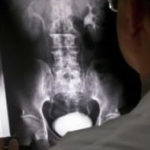Is Rheumatoid Arthritis a Bone Disease?
There are a number of bone diseases that can seriously affect the strength of your bone, making it weak and easy to break. These include osteoporosis, Paget’s disease, osteogenesis imperfect, acromegaly, bone infection, bone cancer, and also other bone problems caused by genetics, poor nutrition, or something else. How about rheumatoid arthritis (RA) – is it a bone disease?
In addition, RA can also affect bone by causing structural joint damage (erosions). It attacks membrane surrounding the joint called ‘synovium’, causing inflammation that over time will make cartilage and other joint structures (including bones) to wear away!
Osteoporosis, also called ‘porous bone’, is a bone disease in which the quantity and quality of bone decrease. It causes your bones to become weak and more fragile. Even sometimes mild stresses (such as coughing, bending over, or a minor fall) can cause a bone fracture.
Bone is actually a living tissue that constantly regenerates (continuously being broken down and regenerated). If the regeneration of new bone is slower than the removal of old bone, osteoporosis occurs. And this imbalance is more likely to occur with age.
 Typically, people will have the highest level of their bone mass by about their late 20s or early 30s – then it will gradually decrease afterward. The older they get, the higher the risk of developing osteoporosis.
Typically, people will have the highest level of their bone mass by about their late 20s or early 30s – then it will gradually decrease afterward. The older they get, the higher the risk of developing osteoporosis.
But though people will naturally have bone loss as they age, in fact not all elderly people experience osteoporosis. This suggests that age doesn’t play alone to cause the disease. Here are other risk factors:
- Other non-modifiable risk factors such as gender (the disease is more common in women), a family history of osteoporosis, small body frames, and certain races (if you’re Asian decent or white for example).
- Diet too low in calcium or other conditions that can affect your calcium intake such as gastrointestinal surgery and eating disorder.
- Hormonal imbalances. The disease could also be a consequence of too low or too high of certain hormones (such as low estrogen during menopause and excessive thyroid hormone).
- Lifestyle factors. These include if you’re a smoker, a sedentary individual, or a heavy drinker (excessive alcohol consumption).
- Certain medications such as long-term use of corticosteroid.
There are also a number of medical conditions that put you at high risk of having osteoporosis. The main ones include inflammatory bowel disease, celiac disease, liver disease, kidney disease, lupus, certain cancers, and multiple myeloma.
So while it’s normal for everyone to lose bone mass with age, certain factors /conditions can speed up this process. How about rheumatoid arthritis?
Ra can also contribute to cause increased risk of osteoporosis, as noted before. According to some studies, the risk of bone loss is relatively higher among those who have RA than the general population.
There are many reasons of why and how RA poses the risk of osteoporosis. The main ones are as follows:
- Chronic, systemic inflammation of the disease. Again RA can affect your body systematically, not only your joints! Bone loss may as a direct result of the disease, too. For example, weakened bone is most pronounced in areas close to the affected joints, though it can affect any site. RA inflammation may also have to do with cytokines, cells that can impact the bones.
- The disease duration. Young patients are more likely to develop RA complications such as osteoporosis. More years with the disease, the higher the risk of developing the complications, this is especially true if the disease is not controlled as well.
- Immobility and disability. The disease is more likely to drive patient to become a sedentary individual.
- Some RA medications are bad for bone. For example; high-dose prednisone, a corticosteroid. For many years, prednisone is one of common culprits in causing bone mineral density loss.
- And traditional osteoporosis risk factors as mentioned above.
Unlike discomfort arthritis pain and stiffness, early bone loss associated with RA is not easy to detect. Even many times, it progresses without any symptom in its early stages.
The good news the disease is controllable and treatable, though it’s incurable (there’s still no curative therapy). The same goes for its complications – RA complications (including RA-related bone loss) are preventable.
With appropriate treatment plan, RA is not the end of everything and patients can expect a normal life span. Some lifestyle measures may also have a role to control the disease and prevent its complications.
If you have RA and do concern about your risk of osteoporosis, here are some important checklists to remember:



